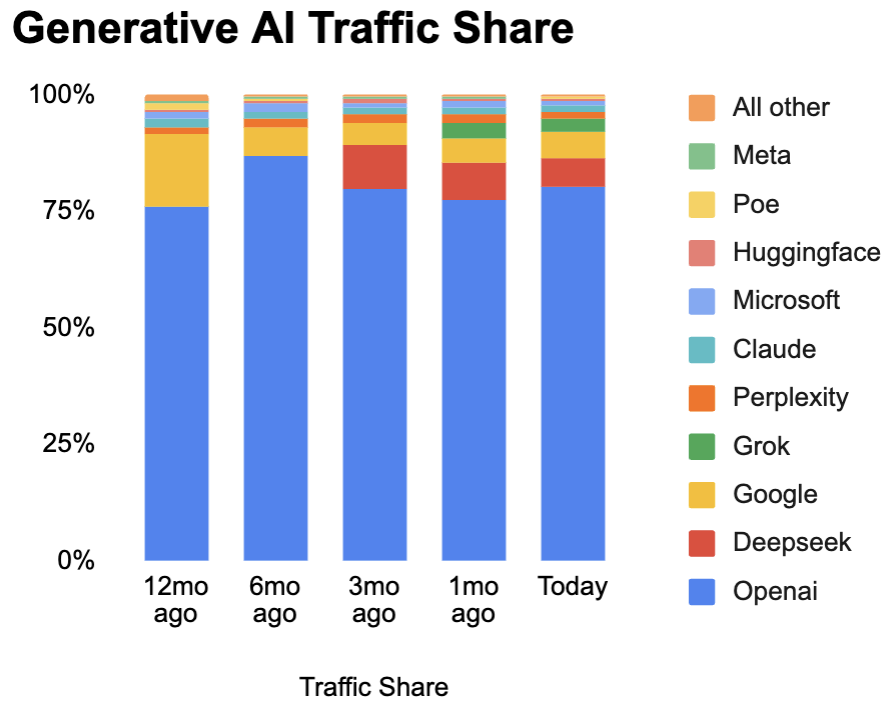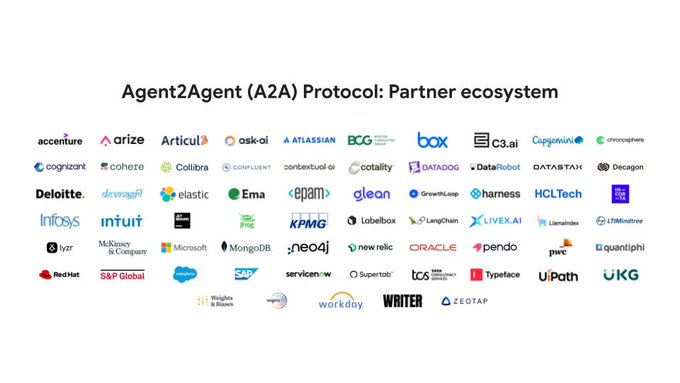Quote of the week
"What are you most afraid of losing, when nothing in the world actually belongs to you?"
- Attributed to Marcus Aurelius

Edition 19 - May 11, 2025
"What are you most afraid of losing, when nothing in the world actually belongs to you?"
- Attributed to Marcus Aurelius

For the first time in 22 years, Google has seen a drop in Safari search traffic, as users increasingly turn to AI tools like ChatGPT and Perplexity. Apple is reevaluating its $20B deal with Google, and Alphabet’s stock dropped 7.3% following the news. While Google points to growth in areas like voice search and AI Overviews, the rise of AI-driven search is reshaping how people find information. This chart is what I imagine Google's search market share looked like back when it was on a rocket. And now, gravity's starting to kick in:

Apple has plans to integrate AI-powered search options like ChatGPT and Perplexity into Safari, as revealed by executive Eddy Cue during a U.S. antitrust trial against Google. While Google will remain the default search engine for now, this move reflects a shift in user behavior and Apple's strategy to offer more AI-driven search experiences.
At the same time, Apple is collaborating with Anthropic to develop an AI-powered coding assistant integrated into Xcode, its software development environment. This tool, based on Anthropic’s Claude Sonnet model, aims to automate code writing, editing, and testing, initially for internal use. Developers could use a chat interface to input requests, manage bugs, and test user interfaces. While Apple has not confirmed plans for a public release, this project reflects broader industry trends where major tech companies increasingly rely on AI for software development.
Recent court rulings stemming from the Epic Games v. Apple case are reshaping the iOS App Store. Amazon’s Kindle app now allows users to buy books via a “Get Book” button that links to the web — a major shift after years of restrictions on external purchases. This change follows legal pressure on Apple to relax its grip on in-app payment systems.

Meanwhile, Apple faces a class action lawsuit from developers who say its new 27% external payment fee violates a 2021 court injunction. At the same time, Apple has asked the court to halt enforcement of new App Store rules, arguing the changes could cause irreparable harm to its business. The battle highlights mounting challenges to Apple’s control over its app ecosystem.
I don't usually shout out books on my newsletter, but the first book from the Red Rising trilogy is one of the best books I've ever read. I finished Red Rising in four days and am already into Golden Son.

Anthropic has launched its AI for Science program, offering up to $20,000 in free API credits to researchers affiliated with institutions, particularly in biology and life sciences. The initiative aims to accelerate scientific discovery by leveraging AI for data analysis, hypothesis generation, and experiment design. Applications are reviewed monthly, focusing on scientific merit, potential impact, and AI's ability to enhance the research.
FutureHouse, a nonprofit backed by Eric Schmidt, has launched a suite of AI tools — Crow, Falcon, Owl, and Phoenix - designed to assist scientists with literature review and experiment planning. While these tools aim to accelerate scientific discovery by leveraging a vast corpus of open-access papers and specialized scientific tools, they have yet to achieve significant breakthroughs. The initiative reflects ongoing efforts to integrate AI into scientific research, though challenges remain in ensuring reliability and fostering genuine innovation. Check out the post here.
Meanwhile, one of the most bizarre stories of the week: a man who survived 856 snakebites may have contributed the key data needed to create a universal antivenom. As ScienceAlert reports, his immune system could help build an AI-trained model to produce synthetic antibodies effective across species.

Researchers at the University of Miami have developed an organic molecule composed of carbon, sulfur, and nitrogen that exhibits unprecedented electrical conductivity, allowing electrons to travel tens of nanometers without energy loss. This breakthrough could lead to smaller, more efficient, and cost-effective computing devices, potentially surpassing the limitations of silicon-based electronics. The molecule's stability under ambient conditions and its potential application in quantum computing further highlight its significance.

If you've been reading my newsletter for a while, you'll remember I referenced stablecoins as a hugely important technology. Stripe has launched stablecoin financial accounts in over 100 countries, enabling businesses to hold, send, and receive U.S. dollar-backed stablecoins like USDC and USDB. This initiative aims to streamline cross-border transactions and enhance financial accessibility, particularly in underbanked regions. Additionally, Stripe introduced an AI-powered Payments Foundation Model to improve fraud detection and authorization rates, leveraging data from billions of transactions to bolster security and efficiency in digital payments.

Meanwhile, the Federal Aviation Administration (FAA) has approved SpaceX to increase its annual Starship launches from 5 to 25 at the Starbase facility in Boca Chica, Texas. This decision follows a comprehensive environmental assessment that concluded the expanded launch schedule would not have significant environmental impacts. While supporters highlight the potential for technological advancement and economic growth, critics express concerns about environmental risks and the adequacy of community engagement in the decision-making process.

And in other news, Coinbase released x402, a new standard for internet-native payments. This was not widely reported on as it was mostly spread on X.
 x402 is an open-source payments protocol that enables instant stablecoin transactions directly over HTTP, utilizing the previously unused HTTP 402 "Payment Required" status code. This innovation allows APIs, applications, and AI agents to conduct real-time, autonomous payments without relying on traditional payment systems like credit cards or subscriptions. By embedding payment capabilities into standard web interactions, x402 facilitates frictionless micropayments and machine-to-machine commerce, paving the way for a more seamless and automated internet economy.
x402 is an open-source payments protocol that enables instant stablecoin transactions directly over HTTP, utilizing the previously unused HTTP 402 "Payment Required" status code. This innovation allows APIs, applications, and AI agents to conduct real-time, autonomous payments without relying on traditional payment systems like credit cards or subscriptions. By embedding payment capabilities into standard web interactions, x402 facilitates frictionless micropayments and machine-to-machine commerce, paving the way for a more seamless and automated internet economy.

Hugging Face has introduced the Open Computer Agent, a free, web-based AI tool designed to autonomously perform tasks within a Linux virtual machine environment. Similar to OpenAI's Operator, this agent can execute commands such as navigating Google Maps or using Firefox. While it handles simple tasks effectively, it struggles with complex operations and CAPTCHA challenges. The initiative aims to demonstrate the advancing capabilities and cost-effectiveness of open-source AI models in powering agentic workflows.
In other news, Google has open-sourced its Agent-to-Agent (A2A) protocol. They also announced the partner ecosystem, full of some of the most innovative and powerful companies in the world.

OpenAI has appointed Fidji Simo, the outgoing CEO of Instacart and former head of the Facebook app, as its CEO of Applications. In this newly created role, Simo will oversee the development and scaling of OpenAI's consumer-facing products, including ChatGPT and other AI-driven applications. She is set to join the company later this year and will report directly to OpenAI CEO Sam Altman.

Simo's extensive experience in product development and monetization at major tech companies positions her to lead OpenAI's efforts in expanding its AI applications to a broader audience. Her appointment signifies OpenAI's commitment to enhancing the accessibility and utility of its AI technologies, aiming to integrate them more deeply into everyday consumer experiences.
After a pandemic-era surge, diabetes deaths in the U.S. are falling again. In 2021, the total reached 103,294—over 17% higher than pre-COVID levels. But by 2024, the number had dropped to 94,294, suggesting the country has regained some control over this long-term public health challenge.
The World Bank reports that India has slashed extreme poverty—from 16.2% in 2011 to just 2.3% by 2023. That’s 171 million people lifted above the $2.15/day threshold, with the majority of gains driven by just five states.
Nature is getting attention as well: new national parks are being planned in the U.S., Scotland, and Australia. And in France, the Paris region has quietly cut air pollution by over 50% in the past 20 years. Cleaner skies are now the norm—and thousands of lives have been saved as a result.

John Deere is harnessing AI to revolutionize agriculture, aiming to enhance efficiency, sustainability, and profitability across its global operations. In a conversation with OpenAI, Justin Rose, President of Lifecycle Solutions, Supply Management, and Customer Success at John Deere, highlighted how AI technologies like the See & Spray system are enabling precise application of herbicides, reducing chemical use by up to 70% by targeting only weeds. This precision agriculture approach not only conserves resources but also boosts crop yields and farmer profitability.

To support this technological shift, John Deere is transitioning to a subscription-based model, offering renewable licenses for its advanced tools. This model lowers upfront costs for farmers and ensures they pay only when they derive value from the technology. Additionally, AI-powered tools are streamlining operations for dealers and support teams by providing instant diagnostics and repair instructions, significantly reducing machine downtime. By integrating AI into every facet of its operations, John Deere is not only modernizing farming practices but also setting a precedent for AI-driven transformation in traditional industries.
It's become a weekly occurrence to bring up the chip battle between the US and China. Nvidia is developing a lower-powered version of its H20 AI chip for China to comply with new U.S. export restrictions, aiming for a mid-2025 release. The move is intended to maintain Nvidia’s $17B foothold in the Chinese market, where demand from major firms like Tencent and Alibaba remains strong despite reduced chip capabilities.

Meanwhile, Huawei is pushing forward with its Ascend AI chips, launching the 910C to match Nvidia’s H100 in performance and preparing the 910D to surpass it. These efforts reflect China’s growing focus on self-reliance in AI hardware, signaling a more competitive and fragmented global AI chip market. We’re watching the semiconductor Cold War in real time, and you'll keep getting the latest from me.
At Config 2025, Figma unveiled a flurry of new tools — including Figma Sites for no-code web publishing, Buzz for team communication, and premium upgrades through Make. While these additions may excite content teams and marketers, they miss the core challenge Figma has yet to solve: scaling design systems across complex enterprise applications. Instead of chasing static site builders, Figma should have focused on deeper infrastructure for product teams.

What enterprise design leaders truly need is a visual application map paired with a living design system manager — tools that connect components to flows, track usage across products, and enforce system-wide consistency. Right now, teams waste countless hours reconciling UI kits, rebuilding flows, and manually syncing design with development. Figma’s dominance in the design file layer is clear, but it has yet to solve the systemic problems that slow down enterprise software creation.
Figma Sites, in contrast, enters a crowded space already well-served by Webflow, Lovable, Bolt, and others. It may boost top-of-funnel growth and help Figma expand horizontally, but it dilutes focus from its strongest asset: the deep integration of design and product workflows. Enterprises don’t need another way to spin up landing pages — they need a way to manage sprawling design systems with confidence, reuse components intelligently, maintain a clear map of the entire product experience, generate and iterate design options with AI, and rapidly put together clickable design prototypes.
Someone will eventually build this, and Figma will fall.
Enjoying The Hillsberg Report? Share it with friends who might find it valuable!
Haven't signed up for the weekly notification?
Subscribe Now